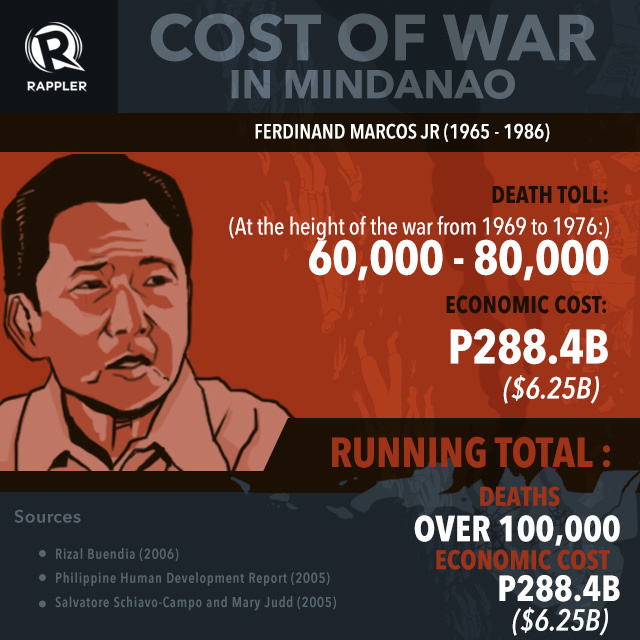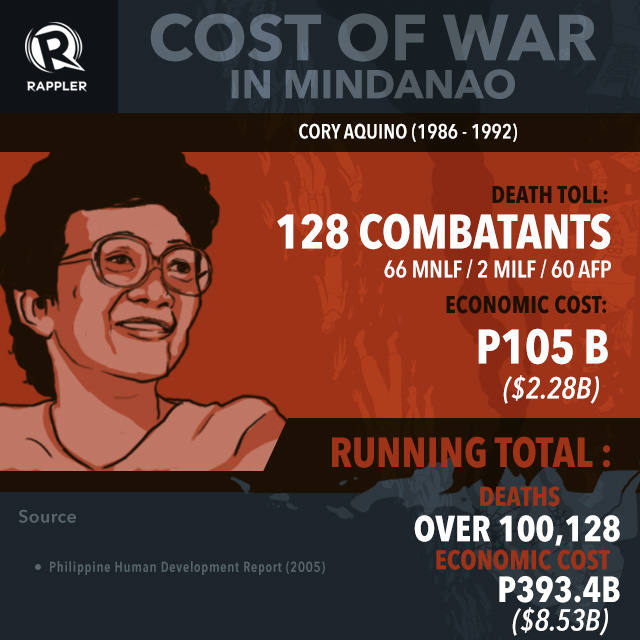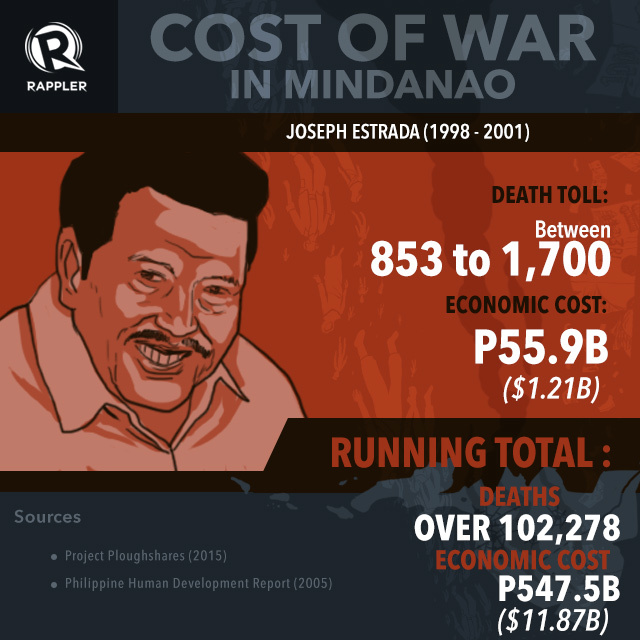In this infographic, we show the cost of war in Mindanao spanning the administrations of Ferdinand Marcos, Corazon Aquino, Fidel Ramos, Erap Estrada, Gloria Macapagal-Arroyo, and Benigno Aquino III

Peace advocates and negotiators are putting up one last fight to have the Bangsamoro Basic Law (BBL) passed before the Senate and House of Representatives adjourn their regular session on Saturday, October 10.
Professor Miriam Coronel-Ferrer, chief negotiator of the government in talks with rebel group Moro Islamic Liberation Front (MILF), said on Wednesday, October 7, that "the BBL should progress before the APEC summit" in November. (Ferrer: Pass Bangsamoro Basic Law before APEC, not December)
Joining Ferrer, Chief MILF peace negotiator Mohagher Iqbal reiterated to media that his group is still committed to the peace process, but noted that the proposed law is "the only route towards peace" in Mindanao.
“Genuine peace with justice is within our grasp and let us not lose this golden opportunity so that long years of conflict will never happen again,” Iqbal said.
Wide public support for the peace talks between the Aquino government and the Moro Islamic Liberation Front (MILF) was eroded after a botched police operation in Mamasapano, Maguindanao in January 2015. It sparked public outrage, casting doubt on the peace process including the proposed law required to implement the historic deal.
The peace agreement with the MILF is in the final phase of deliberations in Congress. However, Speaker Feliciano Belmonte Jr and Senate President Franklin Drilon earlier said that they agreed to delay the passage of the contentious BBL until December 16, 2015.
In Rappler’s 4-minute animation, we captured the highlights of the 40-year-old conflict:
In the infographic below, we take a look at the
consequencies of the armed conflict that spans about 40 years. (READ: TIMELINE: The
long road to the Bangsamoro region)
From 1970 to present, the war has claimed between 100,000 to 150,000 lives – 50% rebels, 30% government troops, and 20% civilians, according to government data.
The total economic loss sustained by Mindanao due to the conflict is pegged at about P640 billion ($13.9 million), according to the Office of the Presidential Adviser on the Peace Process (OPAPP).
In figures and facts, we dissect the death toll and economic cost of the war under 6 presidencies: Ferdinand Marcos Sr, Corazon Aquino, Fidel Ramos, Erap Estrada, Gloria Macapagal-Arroyo, and Benigno Aquino III.
Marcos
Following the Jabidah massacre, Muslim rebels led by Nur Misuari in the southern region of Mindanao formed the Moro National Liberation Front (MNLF) in 1970.
President Ferdinand Marcos declared martial law in 1972 to contain what he described as growing Muslim and communist insurgencies. In 1976, Libyan leader Moammar Kadhafi witnessed the signing of the Tripoli Agreement that provided a framework for autonomy in 13 provinces and 9 cities in
In 1978, one of the MNLF's fiercest ideologues, Salamat Hashim, split from the MNLF and vowed to press ahead with the fight for an independent Islamic state. Salamat and Murad Ebrahim, another prominent rebel commander, formed the MILF in 1981.

Cory Aquino
After the 1986 EDSA People Power Revolution that ousted Marcos, the Aquino administration launched peace talks with the MNLF.
In 1989, the Organic Act for the Autonomous Region in Muslim Mindanao (ARMM) was signed into law.

In 1996, Misuari, on behalf of the MNLF, signed a final peace agreement with the Ramos government.
That year, the MILF, which had long broken away from the MNLF, also entered into informal talks with the Ramos government. But the MILF peace project was put on the back burner, allowing the organization to recruit, establish huge camps in Central Mindanao and become the biggest Muslim rebel movement.

Former president Joseph Estrada mobilized the entire armed forces to crush the MILF and bring down its seat of power in Camp Abubakar, Central Mindanao, in 2000.

Former President Gloria Macapagal-Arroyo resumed negotiations with the MILF, taking a bold step in crafting a draft agreement that triggered widespread opposition from lawmakers and various sectors and which the Supreme Court later on declared as unconstitutional.
In response, two MILF commanders led attacks across mainly Christian areas of Mindanao.

In October 2012, the Aquino administration and the MILF signed a peace agreement in Malacañang. It marked the first time the rebel group stepped into the country’s seat of power.
In March 2014, both parties signed the Comprehensive Agreement on the Bangsamoro (CAB).

MILF chairman Murad Ebrahim, on the other hand, described the peace agreement as the “crowning glory of our struggle.”
*Peso Dollar conversion rate as of October 8, 2015. P46.13 = $1
http://www.rappler.com/move-ph/issues/mindanao/107585-marcos-aquino-cost-war-mindanao

No comments:
Post a Comment
Note: Only a member of this blog may post a comment.